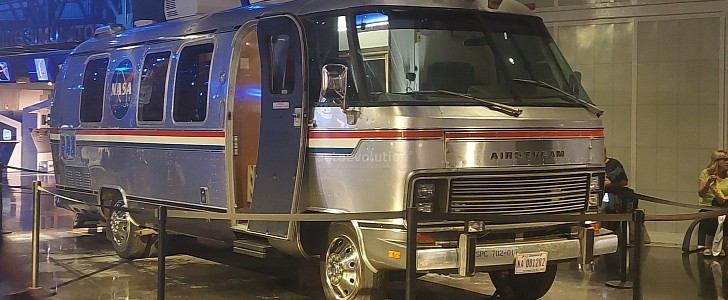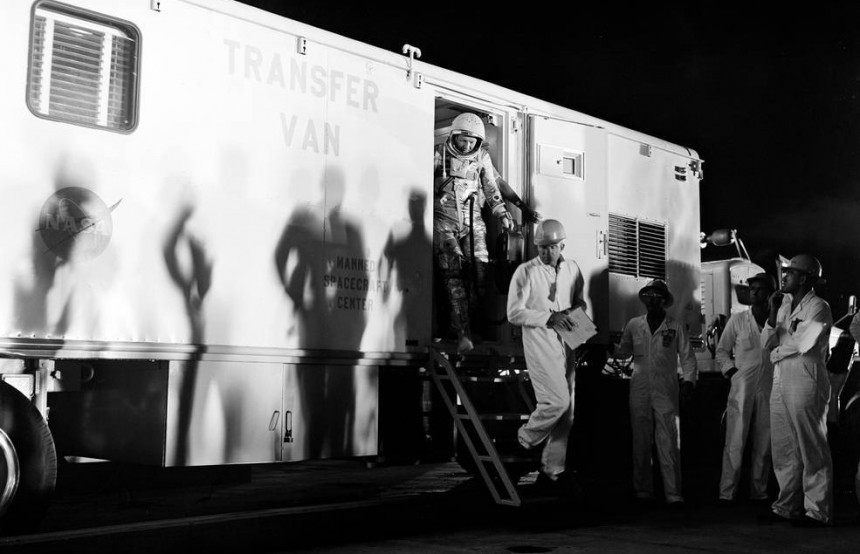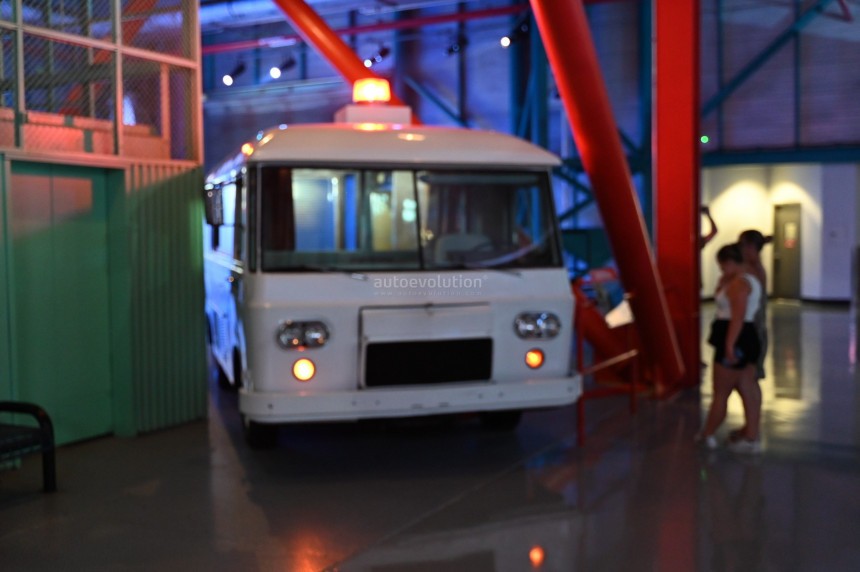As the crow flies, there are roughly three miles (4.8 km) between the Vehicle Assembly Building at NASA's Kennedy Space Center and any of the three launch pads at LC-39. NASA could make its astronauts make the trip in a series of golf carts if they really wanted to. But in the domain of billion-dollar rockets and vast space launch complexes, they get something far more special.
This is the fascinating story behind NASA's Astronaut transfer vans. But most people just call them Astrovans. It just rolls off the tongue so much better. A slew of different American manufacturers and automakers have been tasked with making novel and interesting solutions to the task of bringing space-bound astronauts from NASA's Operations and Checkout Building on Merrit Island, Florida, down past the Vehicle Assembly Building to link up at Launch Control Center with their awaiting booster rocket.
In the earliest days of the Mercury program, America's first manned spaceflight initiative, this job was given to a lowly semi truck with a modified trailer mounted at the back. One particularly telling photograph shows Mercury-Redstone 8's pilot Walter M. Schirra Jr fully suited up, stepping out of this trailer on the way to his awaiting rocket. With fellow astronaut L. Gordon Cooper Jr flanking him in white overalls, you'd expect a construction crew to climb out of the thing after their lunch break instead of astronauts.
Digs would improve somewhat with the successor Gemini program. During which, astronauts were transferred to the launch pad in a perfectly normal American-made box van of unspecified origins. Contemporary film camera from the period leads us to think it was a Chevrolet based on the front clip, but the grainy film quality makes it impossible to say for certain.
A litany of different perfectly typical passenger vans pulled astronaut transport duty during Gemini. It'd take the very first American initiative to land human beings on the surface of another heavenly body to make Astronaut transfer vans become larger-than-life icons in their own right.
Starting with Apollo 7, a highly modified Clark-Cortez motorhome with accommodations for three astronauts, their ground support crew, and all their equipment with room to spare in the rear. As the brainchild of the Clark Forklift Company, these motorhomes were either a Mopar, GM, or Ford product. However, the company wasn't shy about borrowing a part or two from the big three U.S. auto giants.
With a 140-horsepower Chrysler Slant Six under the hood and a four-speed manual transmission, the van was more suited for trundling along with astronauts in tow around the Kennedy Space Center than it would have been as a continent-crushing RV. One can only imagine the slower speeds involved did wonders for the fuel economy.
The plucky converted RV/Van hybrid became a favorite among American astronauts, compact enough to fit into a standard-sized parking space but soft enough in the suspension to not burden the astronauts laden with space suits. The van was so beloved that it wound up serving past the demise of Apollo, up until the sixth flight of the Space Shuttle program, the maiden flight of the Challenger orbiter, in 1983.
Today, the first Astrovan, as most people would identify it, is on display next to the very same Saturn V rocket it once ferried astronauts to inside the Apollo Saturn V complex at Kennedy Space Center's Visitor Complex. In truth, this 1960s RV is only referred to as an astrovan retroactively. So in a sense, it'd be appropriate to call it a Gen-zero or a prototype.
It wasn't until NASA purchased a 1983 Airstream Excella and extensively modified it for astronaut transfer use that the iconic moniker was finally applied. Coming stock with either an Isuzu diesel six-pot or a burly 454-cubic inch gas-V8, this Airstream was undoubtedly less economical than its forbearer. Not that fuel prices were much of an issue back in the early 80s.
It's also not like Space Shuttle astronauts minded this much, either. From shuttle mission STS-9 all the way until the final STS-135 in 2011. The first-generation Astrovan transported all astronauts to their awaiting orbiters.
Two of the Space Shuttle's crews, unfortunately, didn't make it back alive. Today, this too is also on display at KSC's visitor's complex inside the Space Shuttle Atlantis exhibit building. Alongside beautifully heartfelt memorials to each astronaut who gave their lives to the cause of space exploration aboard Space Shuttle orbiters.
Compared to the Tesla Model Xs and lightly breathed on Sprinter platforms, SpaceX's Dragon and Boeing's Starliner are used at the moment, and we bet you're longing for days gone by already. We know we all are.
Check back soon for more coverage from the launch of Artemis I this Saturday, September 3rd, right here on autoevolution.
In the earliest days of the Mercury program, America's first manned spaceflight initiative, this job was given to a lowly semi truck with a modified trailer mounted at the back. One particularly telling photograph shows Mercury-Redstone 8's pilot Walter M. Schirra Jr fully suited up, stepping out of this trailer on the way to his awaiting rocket. With fellow astronaut L. Gordon Cooper Jr flanking him in white overalls, you'd expect a construction crew to climb out of the thing after their lunch break instead of astronauts.
Digs would improve somewhat with the successor Gemini program. During which, astronauts were transferred to the launch pad in a perfectly normal American-made box van of unspecified origins. Contemporary film camera from the period leads us to think it was a Chevrolet based on the front clip, but the grainy film quality makes it impossible to say for certain.
A litany of different perfectly typical passenger vans pulled astronaut transport duty during Gemini. It'd take the very first American initiative to land human beings on the surface of another heavenly body to make Astronaut transfer vans become larger-than-life icons in their own right.
With a 140-horsepower Chrysler Slant Six under the hood and a four-speed manual transmission, the van was more suited for trundling along with astronauts in tow around the Kennedy Space Center than it would have been as a continent-crushing RV. One can only imagine the slower speeds involved did wonders for the fuel economy.
The plucky converted RV/Van hybrid became a favorite among American astronauts, compact enough to fit into a standard-sized parking space but soft enough in the suspension to not burden the astronauts laden with space suits. The van was so beloved that it wound up serving past the demise of Apollo, up until the sixth flight of the Space Shuttle program, the maiden flight of the Challenger orbiter, in 1983.
Today, the first Astrovan, as most people would identify it, is on display next to the very same Saturn V rocket it once ferried astronauts to inside the Apollo Saturn V complex at Kennedy Space Center's Visitor Complex. In truth, this 1960s RV is only referred to as an astrovan retroactively. So in a sense, it'd be appropriate to call it a Gen-zero or a prototype.
It's also not like Space Shuttle astronauts minded this much, either. From shuttle mission STS-9 all the way until the final STS-135 in 2011. The first-generation Astrovan transported all astronauts to their awaiting orbiters.
Two of the Space Shuttle's crews, unfortunately, didn't make it back alive. Today, this too is also on display at KSC's visitor's complex inside the Space Shuttle Atlantis exhibit building. Alongside beautifully heartfelt memorials to each astronaut who gave their lives to the cause of space exploration aboard Space Shuttle orbiters.
Compared to the Tesla Model Xs and lightly breathed on Sprinter platforms, SpaceX's Dragon and Boeing's Starliner are used at the moment, and we bet you're longing for days gone by already. We know we all are.
Check back soon for more coverage from the launch of Artemis I this Saturday, September 3rd, right here on autoevolution.

















